KEY TAKEAWAYS:
Soundfonts are audio sample collections used with software samplers. They are customizable and can be downloaded. For Ableton, create a Soundfonts folder, drag in the .sf2 file, and use Sampler to create music. In Ableton Live 11, create an “Options.txt” file with “-LegacyMultiSampleImport” and restart Ableton to get Soundfonts to work.
Ableton And Soundfonts
Soundfonts are multi-sample files. A MIDI input device can play at different pitches and velocities.
They are a versatile tool for music production.
Ableton’s Sampler instrument allows for the manipulation of soundfonts in various ways.
This guide covers everything you need to know to get Soundfonts working in Ableton. It’s an excellent resource for any producer. They can add depth and character to your productions.
What Are Soundfonts
If you’re new to music production, you may wonder what Soundfonts are. Soundfonts are audio files that contain samples of various instruments or sounds.
These files are then loaded into a software sampler. You can then play the samples back using a MIDI controller. In Ableton, you can use Sampler.
Soundfonts are popular for producers because they offer high flexibility and customization. Soundfonts allow you to manipulate the individual samples within the file. This gives you more control over the final sound.
Another advantage of soundfonts is that they are relatively small, making them easy to store and share. This is particularly useful if you’re working on a project with limited storage space. It also helps with sending your files to someone else for collaboration.
How Do Soundfonts Work?
Now you know what a Soundfont is, how do they work? A Soundfont is a collection of audio samples mapped to specific notes on a MIDI keyboard. The corresponding audio sample is triggered when you play a note on your keyboard.
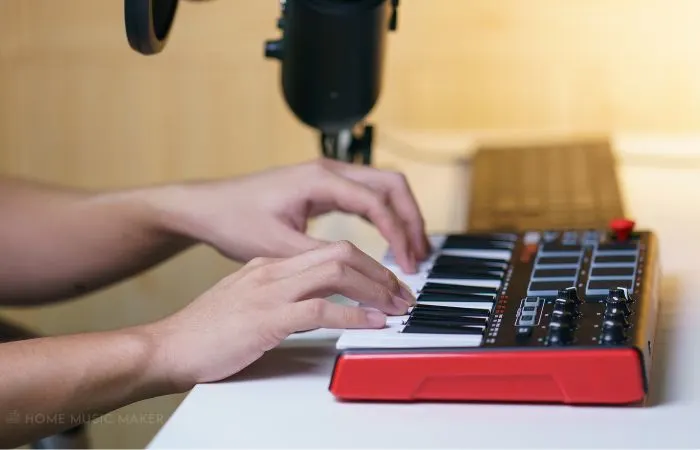
Soundfonts are typically used with software samplers like Ableton’s Sampler instrument. Sampler allows you to load and play Soundfonts. You can also manipulate the individual samples within them to create unique sounds.
One of the advantages of using Soundfonts is that they can be very lightweight in terms of file size. However, they still provide high-quality audio samples.
This makes them ideal for music production. You can load many different instruments and sounds into your project without a huge download.
Another benefit of Soundfonts is that they can be easily edited and customized. Each sample is mapped to a specific note on your keyboard. This means you can adjust individual notes’ pitch, volume, and other parameters.
Additionally, you can layer multiple Soundfonts together to create complex, layered sounds.
READ NEXT:
Unsure whether you need a MIDI keyboard? Check out our article on whether you need a MIDI keyboard to produce music.
Where To Find Soundfonts
If you’re looking to use Soundfonts in Ableton, you’ll need to find some to use. They are usually in the .sf2 file format. There are a few different places you can look to find soundfonts:
- Free Soundfont Libraries: Many websites offer free Soundfont libraries that you can download and use. Some popular options include Soundfonts4u, Hammersound, and The Free Soundfont Library.
- Paid Soundfont Libraries: If you’re looking for more high-quality Soundfonts, consider purchasing a library. The popular choices include Samplephonics, Loopmasters, and Plugin Boutique.
- Create Your Own: If you’re feeling adventurous, create Soundfonts using Ableton’s Sampler instrument. This allows you to sample your own sounds and create custom Soundfonts unique to your music.
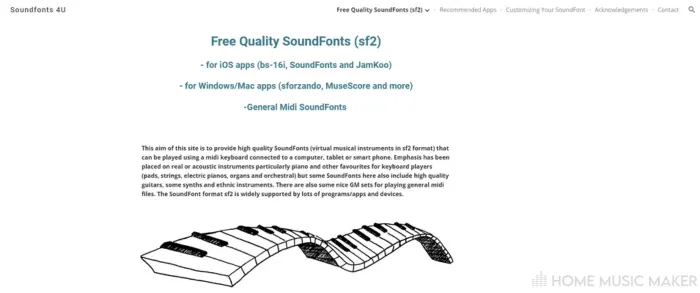
It’s important to remember the genre of music you’re creating when collecting Soundfonts. Different Soundfonts will be better suited for different genres. Be sure to choose ones that fit the style of your music.
READ NEXT:
If you want to sample your own sounds, you will need to know one of the most powerful tools in Ableton. Read our article to learn about Ableton warp modes.
How To Use Soundfonts In Ableton
For any version of Ableton Live before version 11, you can drag in the Soundfont from the sidebar. If you’re using Ableton Live 11, you will need the next section to follow a quick extra step to get Soundfonts to work.
I’d recommend creating a Soundfonts folder so that you can include this in the “Places” section.
To do this, click on the “Add Folder…” option at the bottom of the “Places” section of the sidebar. Then locate your Soundfonts folder in the window that appears. To finish this process, click “Select Folder.”
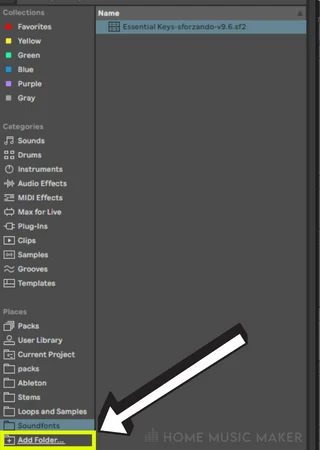
From this folder, you can drag a .sf2 file into your project. This will then import the Soundfont, with all the samples and other files that come along with it. The location of the instruments should then appear automatically in the left-hand sidebar.
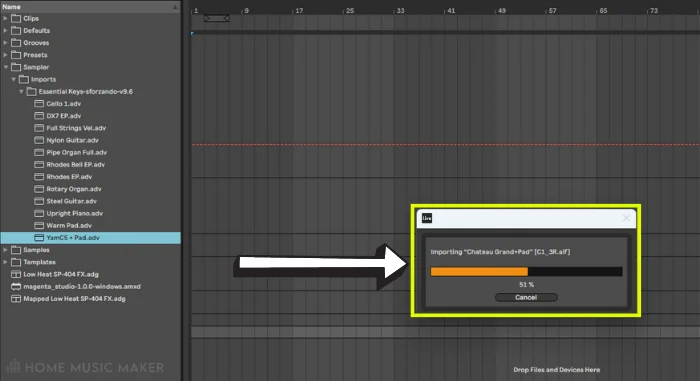
If not, go to the “User Library” tab in the “Places” section of the left-hand sidebar. From there, open up the “Sampler” folder, then open “Imports” and locate the folder with the same name as your .sf2 file.
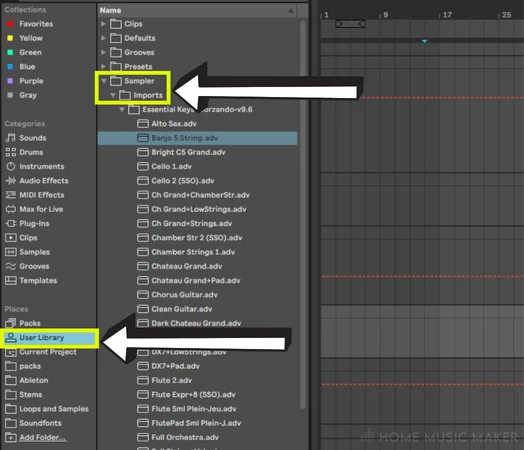
Open up this folder, and there will be multiple .adv files, which you can drag onto a MIDI track. This then opens up an instance of Sampler with all the samples required for that instrument.
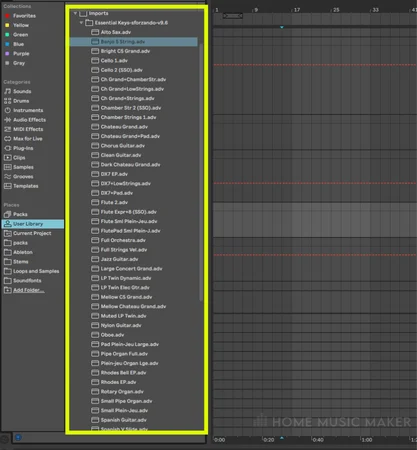
Once you’ve loaded your Soundfont into Ableton’s Sampler, you can use it to create music. Here are a few tips for using soundfonts in Ableton’s Sampler:
- Experiment with different soundfonts to find the right sound for your track.
- Use the Sampler’s filter and envelope controls to shape the sound of your Soundfont.
- Try layering multiple soundfonts together to create unique sounds.
- Use the Sampler’s modulation controls to add movement and variation to your sound.

How To Fix Soundfonts Not Loading In Ableton’s Sampler
If you use Ableton Live 11, the decoder for Soundfont files is not included in Ableton Live 11 by default. Luckily, there is a quick fix.
To get Soundfont files to work in Ableton Live 11, create an “Options.txt” file in the correct location.
First, open a text editor and save the empty plain text file as “Options.txt” in the below location.
For Windows users, you must save “Options.txt” in C:\\Users\[username]\AppData\Roaming\Ableton\Live 11.x.x\Preferences.
For Mac users, save the file in Macintosh HD/Users/[username]/Library/Preferences/Ableton/Live 11.x.x.
In this “Options.txt” file, type in “-LegacyMultiSampleImport” and save. Add this option to a new line if you already have an “Options.txt” file with text.
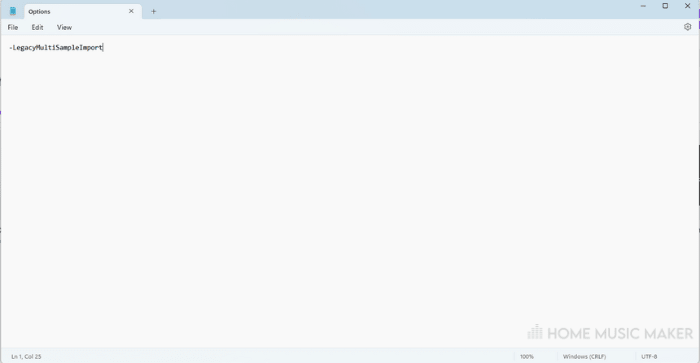
To get this option to be reflected in Ableton Live, you need to restart Ableton Live.
If you want to learn more about the “Options.txt” file, you can follow the tutorial on the Ableton website.
Related Questions
How To Convert SF2 To WAV?
Open Ableton and create a new project. Import the .sf2 file and create a new MIDI track. You can then drag the .sf2 file to the MIDI track.
Create a new audio track, and set the track’s input to the MIDI track with the .sf2 file. You can do this by using the drop-down menu next to the track name, usually set to “Ext. In”.
Arm the audio track for recording. Press recording while playing the MIDI track to trigger the SF2 sounds. Once you have recorded the desired amount of audio, stop recording.
You can then export the recorded audio as a WAV file.
Can You Get Sued For Using Soundfonts?
The use of soundfonts in and of itself is not illegal. Soundfonts are digital sound files that can be used to create music.
Yet, the soundfonts could contain copyrighted material in the samples. So using those Soundfonts could lead to copyright infringement claims and lawsuits. Unless you have permission, you cannot use them in released music.
What’s The Different Between Soundfonts And VST?
Soundfonts are collections of pre-recorded audio samples. VST plugins are software instruments and effects that can be used in a DAW.
How Do You Extract Samples From Soundfonts?
To extract samples from a Soundfont file, you’ll need to use a Soundfont editor. Vienna, Swami, and Polyphone are examples of such software.
Once you’ve chosen a Soundfont editor, load the Soundfont file into the software.
Most Soundfont editors or samplers will display the samples in the Soundfont file. Navigate to the samples you want to extract, select them and export them as individual WAV or AIFF files.
You’ll need to save the exported samples to your desired location on your computer.
What Are The Best Soundfont Players?
– Sforzando
– Vienna Ensemble Pro
– Polyphone
– TX16Wx
– MuseScore
READ NEXT:
Are you relatively new to Ableton? Check out our article on the best way to learn Ableton Live.

 Want to connect with other music producers for help and guidance?
Want to connect with other music producers for help and guidance?